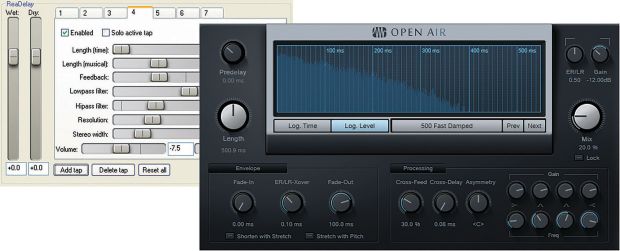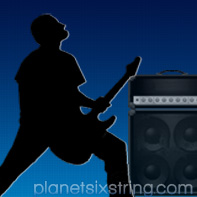
multiple short delays, while PreSonus’s
Open Air (included in Studio One
Professional) loads impulses to create
room ambiances.
How you mix your music determines how listeners will hear your music. For decades, mixing was done through speakers, because that was the dominant way people heard music. A standard recommendation was not to mix through headphones—except as a reality check—because they distorted the sense of space and stereo separation.
Well, the world has changed. The retail value of headphone sales has gone from $1.8 billion in 2005 to $15.5 billion in 2017, and speakers are now about Bluetooth speakers and soundbars—not traditional stereo systems. So why should you care? Because that will influence how you mix your music, and there are some special considerations for guitar.
Guitars are mono instruments. If you take your guitar direct, or go through an amp sim, there will be no natural stereo imaging. Miking amps used to include at least some room ambiance (as would playing back tracks through speakers in a room), but now you need to add it yourself to avoid an artificial vibe. Many sims include reverb, but not many offer ambiance, aside from room reverb. Adding several low-level, stereo echoes from a tapped delay line can restore a sense of space. Cockos Reaper offers its ReaPlugs VST FX suite as a free download (currently Windows only) at reaper. fm/reaplugs. The suite includes a very useful tapped delay for adding lots of short delays. You can also use convolution reverb—such as the Open Air reverb in PreSonus Studio One Professional—and load a room-impulse response. There are many free impulses available on the net, like openairlib.net and voxengo.com/impulses.
Guitar EQ. If you thought creating a mix that translated over different speakers was problematic, mixing for headphones is worse. People might listen over bass-heavy Beats headphones, treble-heavy Ultrasone earphones what came with their smart phone, or the horror known as airline earbuds. With speakers, I’d often add a slight emphasis around 3.5kHz so the guitar would cut through a mix, but with headphones, a little bit of boost in a lower range (750Hz – 2kHz) tends to translate better, because the headphones are right next to the ears, which makes it easier to pick out individual instruments anyway. This also works when listening over speakers—providing too many instruments aren’t colliding in the same frequency range.
Don’t ignore speakers. The first time you listen to speakers after mixing on headphones, you might be surprised. For example, when listening over headphones, you won’t hear any phase cancellation that could mess up the audio when listening over speakers. Just as those who mixed on speakers also listened to headphones as a reality check, it’s now important to listen on speakers as a reality check. The good news: I’ve always found that tweaking a headphone mix so it sounded good on nearfield monitor speakers made it even better on headphones.
Check out craiganderton.com for the latest info on music, personal appearances, “Friday’s Tip of the Week,” and more.

